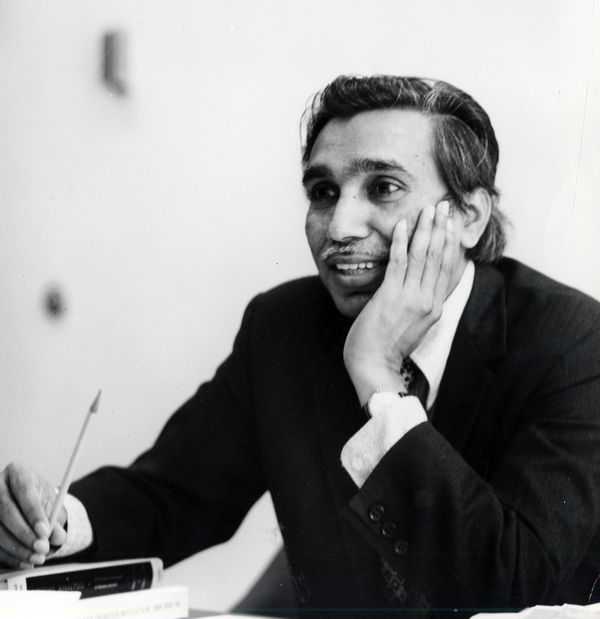
Photograph: Lehigh University
It was 1950 when Fazlur Rahman Khan graduated as a bachelor of science from the Bengal Engineering College of the University of Dhakar as the best student of his year. Benefiting from a Fulbright scholarship, he gained a masters degree in structural engineering and applied mechanics at the University of Illinois in 1952, and three years later was awarded a doctorate in structural engineering at the same university. He joined the Chicago-based architectural practice of Skidmore, Owings & Merill (SOM) later in 1955 and remained there for the rest of his career apart from a two-year interlude (1957–59). He was promoted to participating partner as early as 1961, associate partner in 1966 and, finally, general partner in 1970. During those one-and-a-half decades, Khan developed inno- vative structural systems for high-rise buildings: framed tube, tube-in-tube system, bundled tubes and diagonalised tube (see [Sobek, 2002]; [Mufti & Bakht, 2002]). The basic concept of the framed tube idea is a structural system consisting of a fixed-based vertical tube braced by the horizontal floor plates, which maximises the in ternal lever arm of the high-rise building crosssection. One example of this structural system was the World Trade Center in New York, which was completed in 1973 but unfortunately totally destroyed following the all-too-well-known terrorist attack of 11 September 2001. As a result of the shear lag effect, under horizontal loading those parts of the framed tube parallel to the plane of loading behave like a giant lattice frame. “The columns at the corners attract considerably more load than the columns in the middle of the sides, which means they therefore carry heavier loads than would be expected according to the principles of the practical bending theory” [Sobek, 2002, p. 425]. Like Eric Reissner had shown in 1941 that the shear lag effect governs the design of the thin-wall box beams of aircraft wings [Reissner, 1941], this is also the case for the framed tube, but in a totally different order of magnitude – and that is precisely the challenge of an innovative loadbearing system development. Khan first increased the efficiency of the framed tube by coupling the service core (inner tube) with the outer tube by means of the floor plates (tube-in-tube system) and increased it still further by using the multi-cell high-rise building cross-section (bundled tube). For example, the cross-section of Sears Tower in Chicago (442 m high, completed in 1975) consists of a group of nine individual cross-sections; in structural terms, this skyscraper can be modelled as a vertical cantilever beam with a nine-cell cross-section. Khan, together with B. Graham, realised Myron Goldsmith’s design for the John Hancock Center (344 m high, completed in 1970) [Sobek, 2002, p. 430]. The prominent German structural engineer and architect Werner Sobek has acknowledged Khan’s innovations in loadbearing structures with an impressive quick look at the history of skyscrapers and has called him the “vanguard of the 2nd Chicago School” [Sobek, 2002]. Khan’s objective was to combine architecture and structural engineering. He was a conscious thinker and active citizen, and set up the Bangladesh Liberation Movement in the USA as early as 1971. He was awarded many honours, including honorary doctorates from Northwestern University (1973), Lehigh University (1980) and Zurich ETH (1980). In an obituary of this great engineering personality written in the journal Engineering News Record it says:"The consoling facts are that his structures will stand for years, and his ideas will never die” (cited in [Sobek, 2002, p. 433]). In this sense, his daughter, Yasmin Sabina Khan, has provided us with a living memorial in the shape of her book Engineering Architecture: the vision of Fazlur R. Khan [Khan, 2004].
Main contributions to structural analysis:
Computer design of 100-story John Hancock Center [1966/1]; On some special problems of analysis and design of shear wall structures [1966/2]; 100-story John Hancock Center in Chicago – a case study of the design process [1972]; New structural systems for tall buildings and their scale effects on cities [1974]
Structures and Projects
Participation in the following structures & large-scale projects:
Architect
Chief designer
- John Hancock Center - Skidmore, Owings & Merrill
Structural engineer
- Haj Terminal, King Abdul Aziz International Airport
- The Plaza on Dewitt - Skidmore, Owings & Merrill
- US Bank Center - Skidmore, Owings & Merrill
- Willis Tower - Skidmore, Owings & Merrill
Source: Kurrer, Karl-Eugen The History of the Theory of Structures, Wilhelm Ernst & Sohn Verlag für Architektur und technische Wissenschaften GmbH, Berlin (Deutschland), ISBN 3-433-01838-3, 2008; p. 740/741



Deja tus comentarios
Inicia sesión para publicar un comentario
Enviar un comentario como invitado